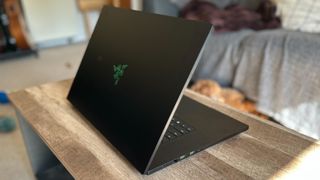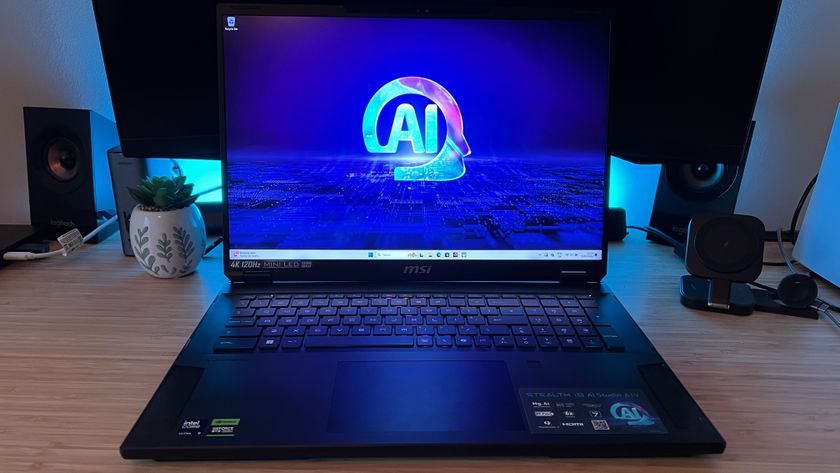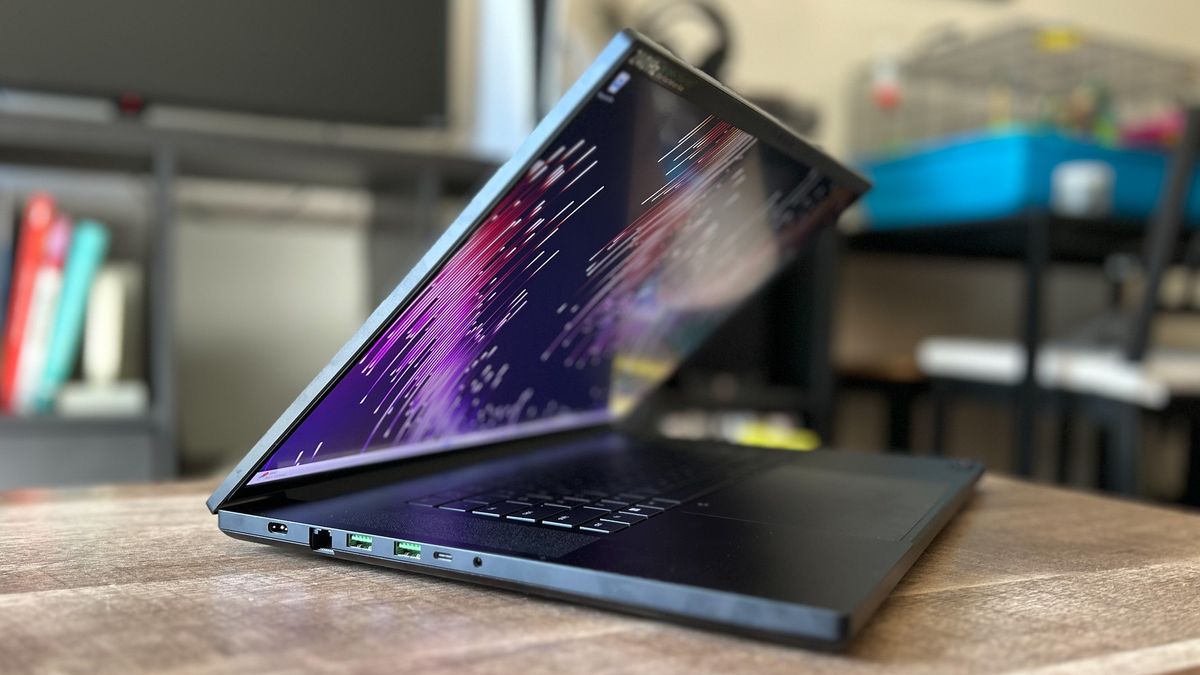12DOVE Verdict
The Razer Blade 18 is a luxury few will actually see. Yes, it posts big numbers in a slimline chassis, but it's one of the most expensive machines on the market right now. Weaker configurations are going to be out-priced by less premium chassis', but if you're after that slick design there's little else out there to scratch such an itch.
Pros
- +
Slimline, slick aesthetic
- +
Durable build feels solid in hand
- +
Massive, incredibly immersive screen
- +
Loads of ports to play with
- +
Upgradeable RAM and storage
- +
Performance is solid considering the form factor
Cons
- -
Too heavy for everyday transport
- -
IPS display is lagging behind competition
- -
Not as powerful as other cheaper units
Why you can trust 12DOVE
It's here. If you thought Razer had made some beastly laptops in the past, you'll be hiding behind a cushion when the Blade 18 rolls into town. Everything about this massive aluminium slab goes hard. Its 18-inch QHD+ 240Hz display, its six upward-firing speaker array, its RTX 4090 / Intel i9-13950HX processor, even its port selection - everything is egregiously OP. And yet it all still fits in that trademark Razer slimline chassis. There's just one problem. It's difficult to see just who Razer is pitching to with its latest release.
The RTX 4090 configuration I've had to rearrange my desk for over the last month comes in at nearly $5,000 (and over in the UK at £5,199.99) - and doesn't match the performance of far, far cheaper machines. This is an incredibly impressive gaming laptop, with blistering speeds and an impossibly skinny form factor - but it's a mad scientist's machine, and one with a price that means it won't see the light of day too often.
Yes, the base RTX 4060 configuration comes in at a more human $2,899.99 - and that's still a splurge that would net you far more impressive components in any other machine. But this isn't any other machine. This is a sleek Razer laptop with an immersive screen and slick unibody build. It's an art piece with an Nvidia graphics card inside.
The Blade 18 has been designed to be parked on a desktop, so that's how I spent the majority of my time testing it. I also took it across the country - that hurt. After all this time working, living, and playing with Razer's new big'un, it's time to see where it sits among the best gaming laptops on the market.
| Spec | Tested | Also Available |
| Price | $4,499.99 / £5,199.99 | $2,899.99 | $3,199.99 | $3,799.99 | $4,999.99 |
| Display | 18-inch QHD+ (2560 x 1600), 240Hz | - |
| Processor | Intel i9-13950HX | Intel i9-13980HX |
| GPU | Nvidia RTX 4090 | Nvidia RTX 4060 | RTX 4070 | RTX 4080 |
| RAM | 32GB DDR5-5600MHz | 16GB DDR5-5600MHz | 64GB DDR5-5200MHz |
| Storage | 1TB SSD (M.2 NVMe PCIe 4.0 x4) | 1TB + 1TB (2TB) PCIe 4.0 NVMe M.2 SSD | 2TB SSD (M.2 NVMe PCIe 4.0 x4) |
| Connectivity | WiFi 6E / Bluetooth 5.3 | - |
| Ports | 3x USB 3.2 Gen 2 Type A, 1x USB 3.2 Gen 2 Type-C (Thunderbolt, PD, DisplayPort 1.4), 1x USB 3.2 Gen 2 Type-C (DisplayPort), 2.5Gb RJ45 Ethernet, HDMI 2.1, MicroSD card reader, 3.5mm audio | - |
| Dimensions | 21.90mm x 275.40mm x 399.90mm | - |
| Weight | 3.1kg | - |
Design
- Same aesthetic as recent Blade releases
- Too heavy for everyday transport but well balanced
- Understated design running throughout
From far away, the Blade 18 could be any laptop in the brand's recent history. This is the same block of black we've come to know and love, and thanks to the 16:10 aspect ratio, it's carrying about the same form factor as last year's Razer Blade 17. Of course, it's slightly bigger but not by a considerable margin. Most of the Blade 18's bulk is carried in its weight. At 3.1kg it's the heaviest gaming laptop I've thrown in a backpack in a while. That means this isn't a portable device, at least not for everyday use. It's still slim, especially by 2023's standards (we're seeing more machines piling on extra bulk in the name of squeezing every ounce of performance out of those new components), but it's still one that's going to stay at home most of the time.

That said, using the Blade 18 as a conventional laptop wasn't as crushing as I thought it might be. Weight is intelligently dispersed across the main body, and the smaller central keyboard (while a little frustrating in its lack of extra features) means typing doesn't tip the machine unnecessarily when perched. It is odd that Razer scrapped the num-pad on its biggest gaming laptop yet, keeping things as lean as possible in the keyboard department, but it makes for a streamlined design that keeps your focus firmly on the Blade's main event; the screen.

With its skinny bezels and stretching panel, the display on the Razer Blade 18 is all-encompassing. I'll get onto the actual experience of using such an immersive screen further down, but from a design perspective, it's clear the entire laptop has been created to keep your attention on what matters most, your gameplay. That may seem obvious at first, but with many brands piling RGB, fancy keyboard legends, extra controls, and unique aesthetic points into their machines, Razer's stripped-back approach feels uninterested in gimmicks. It's aloof but in a cool, self-assured way.
As should be obvious by now, the Blade 18 feels incredibly durable. This is a brick of a machine with a hinge running almost the full length of the chassis and a densely packed main body. With no wobble to the screen or flex in the lower deck, I'm confident this can stand the test of time.
Features
- Immersive, vibrant screen - but IPS panel is disappointing in this generation
- Plentiful ports including Ethernet
- PC-like features including upgradeable RAM and storage
We'll dive in with the reason for the Blade 18's existence, the screen. That 18-inch QHD+ display is an assault on the senses in the best way possible. Packing a 240Hz refresh rate and G-Sync compatibility, everything is buttery smooth here, with impressive color dynamics and detailing. I say impressive because, unlike the Blade 16 (or many new Asus gaming laptops), the 18-incher isn't rocking a MiniLED display. After spending some time with such a screen on the Asus ROG Zephyrus M16 and Asus ROG Strix Scar 16, this sacrifice is palpable. Yes, colors are rich and inviting and the picture is well beyond anything we could have expected just a couple of years ago. The sheer size also helps, feeling more like a dedicated monitor than a portable display to squint at. But as far as screens go, there are far better options out there that won't cost you $5K.

That's disappointing - I've always loved the panels on Razer laptops - they're created for gamers and creatives alike, and while there's still fantastic reproduction and glorious pictures to behold here, having dropped down from the dimming of a MiniLED I can't help but feel like Razer's holding back. Perhaps the brand didn't want to pump extra cash on top of that price tag, but if you're spending this much on a gaming laptop you may well prefer the option to spend a little more considering the Blade 18 centers its existence on this panel. In fact, unlike previous iterations, there are no other display options to choose from. Whichever configuration you pick you're getting this 240Hz QHD+ screen - there is no 4K option.
True, even the latest and greatest RTX 40-Series graphics cards would still have a hard time pumping out demanding titles on a 4K panel of this size. But those looking for a content creation machine will be looking elsewhere this generation.
Outside of that display, the Blade 18 sports a feature set that positions it well within the range of a desktop PC. Ports are bountiful, with three USB-A ports, one USB-C offering Thunderbolt 4 and Display Port direct to the Nvidia GPU (and another with DP to the integrated graphics), an Ethernet port, HDMI 2.1, 3.5mm audio, and an SD card reader. I was able to connect everything I needed to here, whereas I'm usually using a separate hub for my everyday Asus TUF Dash F15.

You'll even be able to upgrade RAM and storage when the time comes. While it's been commonplace to swap out RAM on a gaming laptop for a few years now, it's always been far trickier to get a new SSD in your beloved. The Razer Blade 18 will accommodate up to 64GB DDR5-5200MHz with space for up to 8TB of SSD storage as well.
I was surprised by the clarity of the FHD webcam here - it's certainly one of the better-integrated lenses I've come across, though still won't hold up for more professional streaming sessions.
Under the hood, the Blade 18 can be configured with a range of Nvidia RTX 40-Series graphics cards, ranging from a 4060 to 4090. The majority of Blade 18 models ship with an Intel i9-13950HX CPU, though the most expensive version can be pumped up with an Intel i9-13980HX. Those specs are solid, and mirror those of a similarly priced Asus ROG Strix Scar 18 (while dropping the aforementioned screen features). If you're going this far up the component spectrum, you can expect to pay these top-range prices - the problem is you don't necessarily need to.
Performance
- Performs well considering its slim form factor but...
- ... not quite as reliably as cheaper, thicker machines
- Plenty of power being drawn from CPU
Kicking things down to an RTX 4080 or RTX 4070, in my experience of testing this latest generation of laptops, doesn't hinder your performance as much as the price difference might suggest. The Asus ROG Strix Scar 16 I tested posted better in-game benchmark numbers than the Blade 18, and did so with an RTX 4080 and over $1,000 off the final price. The form factor of this latest design is slightly holding it back. Of course, these numbers are nothing to sniff at - and Razer laptops have never led in performance. They lead in overall experience and luxury.
Fire Strike: 26,844
Time Spy: 16,367
PC Mark 10: 7,338
For now, nobody's going to be complaining about the Razer Blade 18's performance. It's still reaching good numbers, even with its slimline design, but concerns arise when you consider the next five years of gaming coming our way. The rock-solid 100+ framerates we're seeing in other machines with this hardware are purely for vanity right now, but the power they represent will likely become required in the future. When you're spending this much on a laptop, it needs to go the distance.
The Blade 18 trailed slightly in its graphical tests, still beating some 2023 competition with its 16,367 Time Spy score but coming in behind when it comes to Fire Strike. Similarly, Nvidia-friendly games performed nicely, it's just those heavy-hitting titles that caused performance to dip. Metro Exodus and Red Dead Redemption 2 didn't quite hit the mark of the Blade 18's contemporaries, with framerates dropping behind the Asus ROG Zephyrus M16, Asus ROG Strix Scar 16, and Asus ROG Zephyrus Duo 16.

Still, considering the fact these machines can't compete with the Blade 18's skinnier style there's plenty to celebrate here. In real-life gameplay, everything absolutely sang. From speedy load times to barely a jitter in dense Borderlands gunfights, you're certainly not sacrificing too much by opting for a slimline chassis.
| Benchmark Test | 1080p | QHD+ |
|---|---|---|
| Shadow of the Tomb Raider | High: 162fps | Highest: 160fps | High: 159fps | Highest: 155fps |
| Total War: Three Kingdoms | High: 185fps | Ultra: 148fps | High: 127fps | Ultra: 92fps |
| Metro Exodus | High: 92fps | Ultra: 90fps | High: 88fps | Ultra: 77fps |
| Red Dead Redemption 2 | Balanced: 87fps | Highest: 84fps | Balanced: 83fps | Ultra: 81fps |
| The Division 2 | High: 153fps | Ultra: 151fps | High: 142fps | Ultra: 137fps |
Should you buy the Razer Blade 18?

Let's not forget Razer is the Apple of the gaming hardware world. Don't get me wrong, I'm fully in both ecosystems, but they do prioritize luxury experience and ease of use over raw performance. Other brands will sacrifice the former to achieve the latter, your purchase decision comes down to which you value more. If you're after a slick machine with an immersive screen and a pared-down aesthetic, the Blade 18 is going to be a wise investment.
Its chassis is the cleanest design out there, and one of the most solid feeling to boot. Plus, with the slimmed bezels and 16:10 form factor, it's not going to take up much more space than a 17.3-inch device would have last year. However, for anyone after an all-rounder, the value just isn't here. Performance suffers as a result of that skinnier footprint - something that can be avoided by spending less cash.
There is a market for the Razer Blade 18, but those with the cash to throw at luxury items without prioritizing performance are going to be few and far between.
How we tested the Razer Blade 18
I used the Razer Blade 18 solely for two weeks, testing alongside the Asus ROG Zephyrus Duo 16 for two weeks before that. In those two weeks, I completed all work on the machine in both desktop and laptop mode, and played Planet Coaster, Borderlands: The Pre-Sequel, and CS:Go in everyday usage. I also stress-tested using in-game benchmarks found across Shadow of the Tomb Raider, Total War: Three Kingdoms, Metro Exodus, Red Dead Redemption 2, and The Division 2. For more information on how we test gaming laptops, check out the full 12DOVE Hardware Policy.
We're also rounding up all the best Alienware gaming laptops if you're after a different brand. You'll also find our guide to the best gaming PC if you're after something more substantial as well.

Managing Editor of Hardware at 12DOVE, I originally landed in hardware at our sister site TechRadar before moving over to GamesRadar. In between, I've written for Tom’s Guide, Wireframe, The Indie Game Website and That Video Game Blog, covering everything from the PS5 launch to the Apple Pencil. Now, i'm focused on Nintendo Switch, gaming laptops (and the keyboards, headsets and mice that come with them), PS5, and trying to find the perfect projector.



















The Wheel of Time showrunner defends Prime Video show's big changes from the books following season 3 backlash: "You have to be careful not to be swayed by Reddit"

League of Legends' take on Balatro is one of its best mini-games yet – and it's also exactly what's wrong with this era of League of Legends

I think Backbone might have had some help with its new Xbox Edition mobile controller




